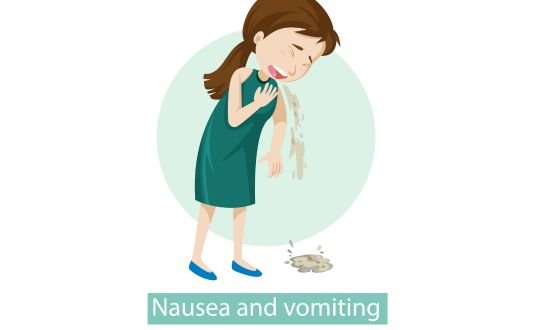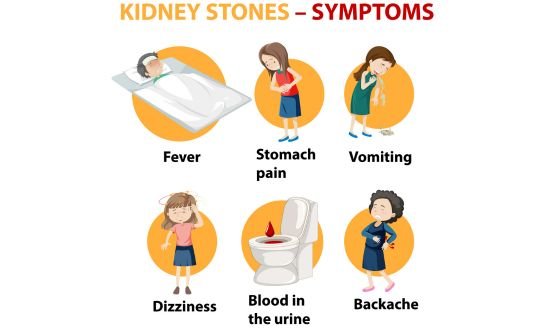Back pain with nausea or vomiting are three symptoms that are commonly unrelated but these can occur at same time in some conditions. Having these symptoms simultaneously can badly affect your daily routine. In this article, we will briefly discuss back pain with nausea or vomiting individually, followed by explaining the connection between these symptoms and available effective solutions to feel better.
Understanding Back Pain
Back pain is a common issue faced by people of all ages. It can range from mild pain to severe discomfort. Therefore, it is important to understand its types, causes and treatment methods.
Types of Back Pain
- Acute vs. Chronic: Acute back pain comes on suddenly and typically lasts for a shorter period of time, while chronic pain persists for more than three months.
- Localized vs. Radiating: Localized pain is limited to one area, whereas radiating pain may travel down the legs (sciatica) or to other parts of the body.
Common Causes of Back Pain
- Muscle Strain: Overexertion, poor posture or lifting heavy objects can strain back muscles.
- Herniated Discs: Discs in the spine can rupture or bulge which can result in pressing on nerves and causing pain.
- Spinal Stenosis: Narrowing of the spinal canal can compress nerves and result in pain in upper and lower back.
- Posture and Lifestyle Factors: Prolonged sitting, obesity and poor ergonomics can contribute to back pain.
To read more about back pain do follow
What is Nausea?
Nausea is an uncomfortable feeling in the stomach that is frequently accompanied with the desire to vomit. Although, it can have many different origins and causes. Nausea is a complex feeling that is commonly mistaken for a simple stomach issue.
Triggers and Causes
- Motion Sickness: Traveling in cars, boats or planes can trigger motion sickness and nausea.
- Food Poisoning: Eating contaminated food or beverages can cause nausea.
- Medication Side Effects: Some medications cause nausea as a side effect.
- Emotional Stress: Anxiety, depression or stress can lead to feelings of nausea.

Defining Vomiting
Vomiting is an involuntary reflex in which the body tries to expel harmful or irritable substances from the body. This reflex is controlled by brainstem.
Factors Causing Vomiting

- Gastrointestinal Infections: Viral or bacterial infections can irritate the stomach lining which can trigger vomiting.
- Pregnancy: Morning sickness is a common symptom during pregnancy.
- Chemotherapy: Cancer treatments can cause severe nausea and vomiting.
- Migraines: Severe headaches can cause nausea and vomiting.
Back pain with Nausea or Vomiting: Identifying Common Causes
While these are three different symptoms but they often share common underlying factors.

Medical Conditions
- Kidney Stones: These small, hard mineral deposits that form in the kidneys can cause severe, cramping abdominal pain. This pain can radiate to the lower back and with accompanying severe discomfort it can cause back pain with nausea or vomiting.
- Gastroesophageal Reflux Disease (GERD): GERD is a digestive disorder characterized by the backward flow of stomach acid into the esophagus. This can lead to heartburn, chest pain, and regurgitation of stomach contents, which may cause nausea and even vomiting. The irritation of the esophagus can also upper back pain.
- Pancreatitis: Inflammation of the pancreas, known as pancreatitis, can cause upper abdominal pain that may be felt in the back as well. Nausea and vomiting are common symptoms of pancreatitis, especially in case of acute and severe pancreatitis.
- Gallstones: Gallstones are solid particles that form in the gallbladder. When a gallstone becomes lodged in the bile duct, it can cause severe abdominal pain which often cause radiating back pain with nausea or vomiting.
- Appendicitis: Inflammation of the appendix is known as appendicitis. It typically presents with severe lower right abdominal pain. This pain can migrate to the back and is often associated with nausea and sometimes vomiting.
- Stomach Ulcer: An ulcer in the stomach or duodenum can cause gnawing or burning pain in the upper abdomen. This can also cause radiating back pain with nausea or vomiting especially if it is a perforated or bleeding ulcer.
- Menstrual Pain (Dysmenorrhea): Menstrual cramps are a common cause of lower abdominal pain in women during their menstrual periods. These cramps can sometimes radiate to the lower back and may be accompanied by nausea.
- Endometriosis: Endometriosis is a condition in which tissue similar to the uterine lining grows outside the uterus. It can cause pelvic pain, pain in lower back and in severe cases it causes nausea which can lead to vomiting, particularly during menstruation.
By completely understanding these overlapping causes individuals and healthcare providers can identify the root cause of the problem. In order to achieve complete recovery, it is important to address both the immediate symptoms and the underlying factors.
Lifestyle Causes
- Stress and Anxiety: Chronic stress and anxiety can exacerbate back pain with nausea or vomiting.
- Poor Diet: Unhealthy eating habits can contribute to back pain and digestive issues.
- Sedentary Lifestyle: Lack of physical activity can exacerbate back pain and affect digestion.
Environmental Factors
- Foodborne Illnesses: Contaminated food can cause both gastrointestinal distress and pain in back due to muscle tension.
- Air Pollution: Environmental factors can exacerbate respiratory issues and indirectly lead to nausea.
Back pain with Nausea or Vomiting: Serious Medical Conditions
Sometimes back pain with nausea or vomiting can be indicative of more serious medical conditions.
Gastrointestinal Disorders
- Irritable Bowel Syndrome (IBS): IBS can cause chronic abdominal pain, nausea and vomiting.
- Crohn’s Disease: This inflammatory bowel disease can cause nausea, severe abdominal pain and vomiting.
Neurological Disorders
- Multiple Sclerosis: Neurological disorders like MS can lead to a wide range of symptoms, including back pain with nausea or vomiting.
- Brain Tumors: Tumors in the brain can exert pressure on areas responsible for nausea and vomiting.
Systemic Diseases
- Diabetes: Uncontrolled diabetes can lead to neuropathy and pain in back.
- Autoimmune Disorders: Conditions like lupus can cause joint pain and gastrointestinal symptoms.
- Cancer: Various types of cancer can result in back pain with nausea or vomiting.
Effective Options for Management:
Management of back pain with nausea or vomiting is done by multifaceted approach. It includes lifestyle changes, home remedies and medical interventions. Following are the effective strategies for the treatment of back pain, nausea and vomiting .
Treating Back Pain:
- Exercise and Physical Therapy: Doing regular physical activity can help in strengthening of the muscles supporting the spine. Physiotherapy by a professional physiotherapist can help in improvement of posture and alleviate pain.
- Medications: Over-the-counter pain relievers like ibuprofen or acetaminophen can help in temporary relief for mild to moderate back pain. For severe pain, prescription medications may be necessary.
- Surgical Options: In cases of severe spinal issues, surgical interventions such as discectomy (for herniated discs), spinal fusion, or laminectomy may be considered. These options are typically considered when conservative treatments fail.
To know further in detail pleasehttps://medicalinquiries.com/pain-in-upper-back-after-sleeping/#c-medical-treatment-of-back-pain
Managing Nausea:
- Dietary Modifications: Avoiding trigger foods or beverages that exacerbate nausea, such as spicy or greasy foods, can be helpful. Opt for soft diet or easily digestible meals like plain rice or crackers.
- Hydration: Staying hydrated is essential when experiencing nausea. Sip clear fluids like water, ginger tea, or electrolyte-rich drinks to prevent dehydration.
- Ginger: Ginger has natural anti-nausea properties. Consider ginger tea, ginger candies, or ginger capsules as a remedy. Consult a healthcare provider before using ginger supplements, especially if you are pregnant or on medications.
- Acupressure Bands: Wristbands designed to apply pressure to specific acupressure points can alleviate nausea, especially in cases of motion sickness or morning sickness during pregnancy.
- Prescription Medications: For severe and persistent nausea, a healthcare provider may prescribe antiemetic medications, such as ondansetron or promethazine.
Managing Vomiting:
- Rest and Hydration: After vomiting, it’s important to rest and focus on rehydration. Start with small sips of clear fluids and gradually progress to soft diet like crackers or toast once vomiting subsides.
- Anti-vomiting Medications: In certain cases, prescription antiemetic drugs can help to control vomiting. These are often prescribed for conditions like chemotherapy-induced nausea and vomiting.
- Identify Triggers: Identify and avoid triggers that induce vomiting. They can be any specific food, smell or motion-related factors.
- Deep Breathing and Relaxation: Deep breathing exercises and relaxation techniques can help manage the anxiety and discomfort associated with vomiting episodes.
- IV Fluids: In severe cases of vomiting, especially when accompanied by dehydration, intravenous (IV) fluids administered in a healthcare setting may be necessary.
In cases where back pain with nausea or vomiting are interconnected due to an underlying medical condition, such as gallstones or appendicitis, addressing the root cause through medical treatment or surgery is the exact solution.
Prevention and Self-Care for Back pain with Nausea or Vomiting
Prevention plays an important role in managing back pain with nausea or vomiting and improving overall well-being.
Reducing Risks:
- Maintain a good body posture by keeping your back straight while sitting or standing will help in preventing pain.
- Doing regular exercise like walking and weight training will help in strengthening your back muscles.
- Avoid straining your back while lifting heavy objects by bending your knees and using your legs.
- Drink plenty of water to protect yourself from dehydration which can cause nausea and vomiting.
Dietary and Lifestyle Changes:

- Eat a balanced diet which contains variety of fruits, vegetables, lean proteins and whole grains.
- Identify and avoid foods like spicy or greasy items that can worsen your symptoms.
- Reducing alcohol and caffeine intake can help in preventing the symptoms.
- Practice stress-reduction techniques like deep breathing or yoga daily.
Red Flags: When to Contact a Doctor?
You should immediately consult a doctor in following conditions:
- Severe, persistent back pain that doesn’t improve with rest or over-the-counter pain relievers.
- Back pain accompanied by numbness or weakness in your legs, especially if it’s worsening.
- Nausea and vomiting with blood or coffee-ground-like material.
- Vomiting that persists for more than 24 hours, especially in children and the elderly.
- Back pain with nausea or vomiting following a recent injury or trauma.
- Unexplained weight loss accompanied by any of these symptoms.
- Severe abdominal pain with vomiting, especially if it’s on the right side (possible appendicitis or gallstones).
FAQs:
- Can back pain lead to nausea and vomiting?
Yes, in certain cases, severe back pain can lead to nausea as well as vomiting.
- Is nausea always associated with vomiting?
No, nausea can occur independently of vomiting.
- When should back pain with nausea or vomiting be considered a medical emergency?
When these are accompanied by severe pain, dehydration or red flags symptoms like blood in vomiting.
- Are there any home remedies that can provide relief for back pain with nausea or vomiting?
There are many home remedies that include staying hydrated, good posture, ginger for nausea, and rest.
Conclusion
Back pain with nausea or vomiting are interconnected symptoms that can indicate an underlying health issue. Thorough understanding of these shared causes and seeking timely medical help for their treatment can help you achieve better health and well-being.
Disclaimer
Content on this site is written with thorough research and keeping in mind the latest guidelines. However, no content on this site should substitute professional consultation.
